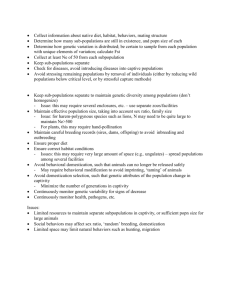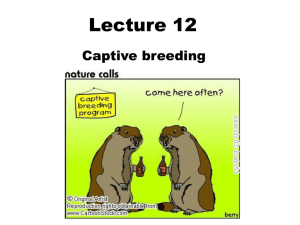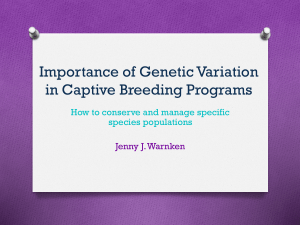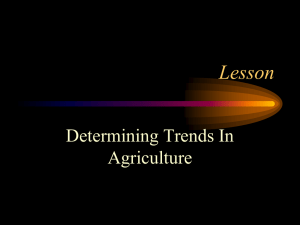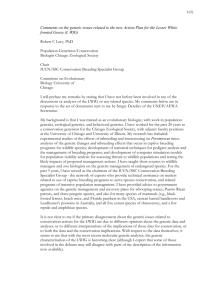Chapter 19 Practice Problems
advertisement
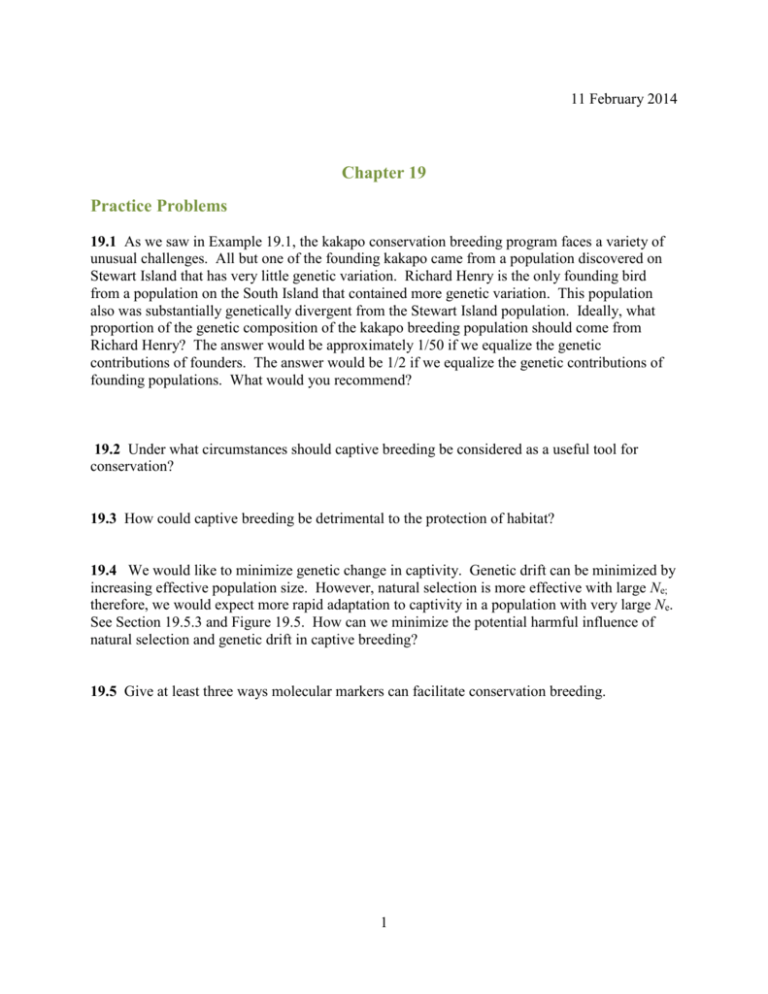
11 February 2014 Chapter 19 Practice Problems 19.1 As we saw in Example 19.1, the kakapo conservation breeding program faces a variety of unusual challenges. All but one of the founding kakapo came from a population discovered on Stewart Island that has very little genetic variation. Richard Henry is the only founding bird from a population on the South Island that contained more genetic variation. This population also was substantially genetically divergent from the Stewart Island population. Ideally, what proportion of the genetic composition of the kakapo breeding population should come from Richard Henry? The answer would be approximately 1/50 if we equalize the genetic contributions of founders. The answer would be 1/2 if we equalize the genetic contributions of founding populations. What would you recommend? 19.2 Under what circumstances should captive breeding be considered as a useful tool for conservation? 19.3 How could captive breeding be detrimental to the protection of habitat? 19.4 We would like to minimize genetic change in captivity. Genetic drift can be minimized by increasing effective population size. However, natural selection is more effective with large Ne; therefore, we would expect more rapid adaptation to captivity in a population with very large Ne. See Section 19.5.3 and Figure 19.5. How can we minimize the potential harmful influence of natural selection and genetic drift in captive breeding? 19.5 Give at least three ways molecular markers can facilitate conservation breeding. 1 Assignment Problems 19.6 The sauger (Sander canadensis) is a highly migratory, cool-water sport fish in the family Percidae that occurs in large, turbid river systems throughout much of the Mississippi, Great Lakes, and Hudson Bay drainages of North America (Bingham et al. 2012) . Historically, saugers were widely distributed throughout their native range; however, many populations have declined due to water development, habitat destruction, and fragmentation. Thousands of sauger that were produced from five males and two females collected from the Wind/Bighorn River drainage were reside at the Garrison National Fish Hatchery in North Dakota. Some biologists have recommended that these hatchery progeny be stocked in the Wind/Bighorn River drainage to supplement the fishery. Do you think this is a good idea? Write a brief letter to the USFWS describing what possible genetic problems could result from this action. 19.7 Weeks et al. (2011) have considered the minimum founding population size that should be used when founding new populations for conservation purposes. They recommend that at least 20-50 should be used to found new populations in order to “capture >95% of the standing genetic variation within the source population”. Do you agree with this recommendation? 19.8 Woodworth et al. (2002) used fruit flies (Drosophila) as a model system for captive breeding in conservation. They brought wild flies into captivity and raised them under benign captive conditions (excess of food and space) in a series of replicates with effective population sizes of 25, 50, 100, 250, and 500. The populations then were transferred to crowded conditions to simulate competitive “wild” conditions after 50 generations in captivity. Populations that were kept at intermediate size during the first 50 generations of captivity had the greatest reproductive fitness under “wild” conditions. That is, the largest (Ne = 500) and smallest (Ne = 25) populations had the lowest fitness after being transferred to “wild” conditions. (a) How would you explain these results? That is, what mechanism of genetic change is likely to be responsible for the greater decline in fitness during captivity of the smallest population? What mechanism of genetic change is likely to be responsible for the greater decline in fitness during captivity of the largest population? (b) What are the implications of these results for designing captive breeding programs in conservation? 2
